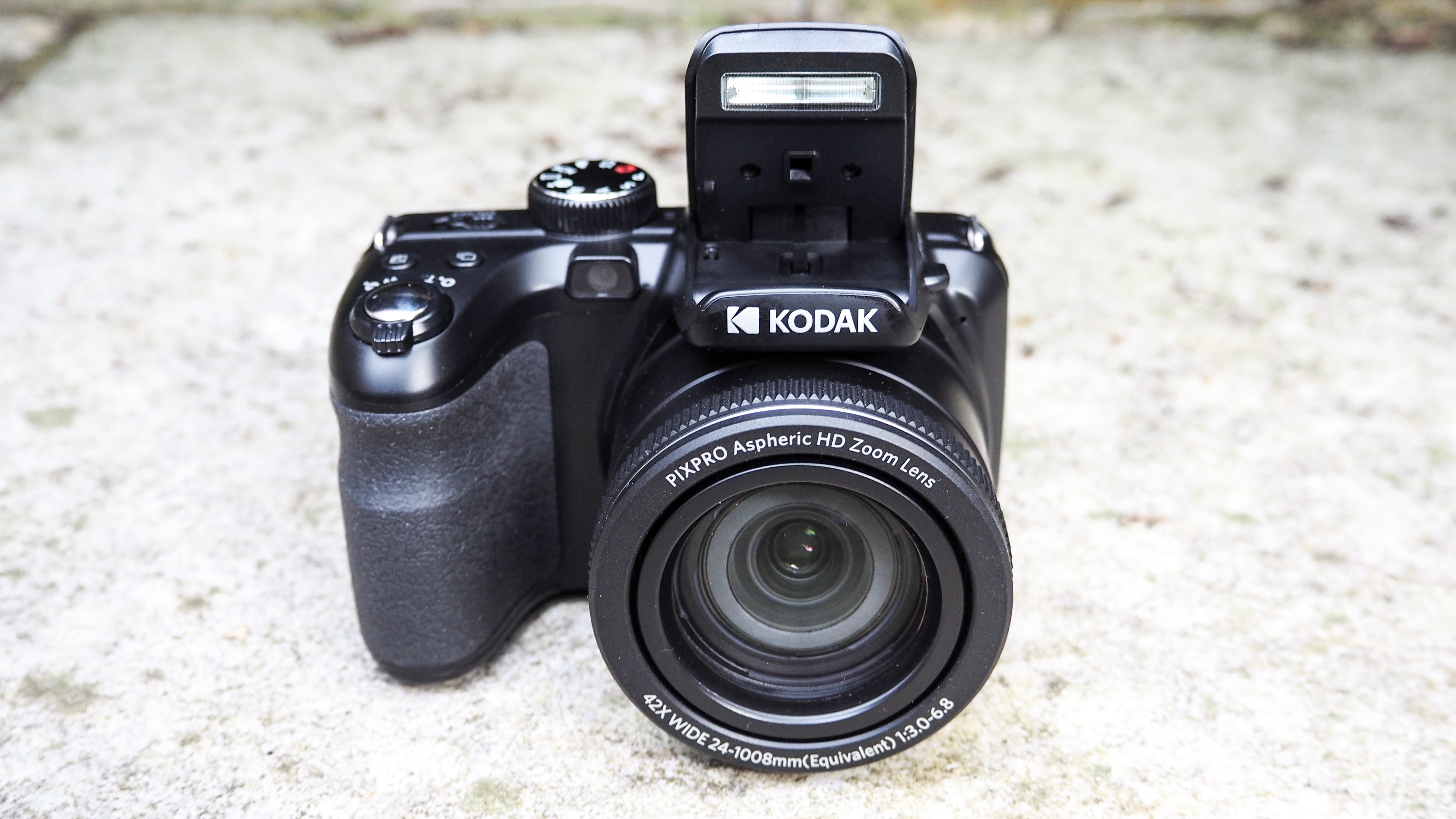
We reviewed the 52x optical zoom incorporating Kodak Pixpro AZ528 a while ago – an all-in-one point-and-shoot that was something of an anomaly amidst high-ticket-price mirrorless camera launches. The latest Kodak-branded addition to our test bench similarly feels like an exception in the present climate. The Kodak Pixpro AZ425 offers a more modest 42x optical reach compared with its sibling snapper.
Rather than offering updated innovations, both cameras are throwbacks to the bridge cameras and superzooms of the early 2000. At the time these plastic-y leviathans plugged a gap between pocket snapshots with 3x optical zooms and more fully featured digital SLRs. But now nobody except Kodak, or rather its current license holder JK Imaging, is making models like the AZ425 any more. Rather grandly the ‘AZ’ stands for ‘Astro Zoom’. Equipped with a steady tripod, there is the potential to frame the moon, for sure.
The Achilles’ heel of such models isn’t their plastic-y build and lack of eye-level viewfinder to keep costs down and make them affordable alternatives to a DSLR and comparable lens however, but rather the small 1/2.3-inch sensor at their heart. This means image quality of the AZ425 is typically no match for photo enthusiast or ‘vlogger’ targeted alternatives which have a larger one-inch sensor, or of course APS-C or full-frame sensor incorporating mirrorless cameras. This type of superzoom really is all about creative flexibility when it comes to framing images from a static viewpoint, thanks to the whopper of a lens on the front of the Kodak AZ425.
This definitely makes it a potentially enticing alternative to the smartphone in our pocket for snapshot photography, even if it is not as portable overall. So how does this standalone camera fare in practice?

Specifications
Sensor: 21.14 megapixel backside illuminated 1/2.3-inch CMOS
Sensitivity range: Automatic, ISO100-3200
Video: Full HD 1920x1080 pixels at 30fps
Lens: 42x optical zoom, 24-1008mm equivalent in 35mm terms
Monitor: 3-inch LCD, 460k dot resolution
Viewfinder: No
Battery life: 240 shots (based on CIPA standards)
Dimensions: 112.7x81.6x84.4mm / 4.44x3.21x3.32-inches
Weight: 444g
Key features

As we’ve established, the key reason for considering buying the Kodak Pixpro AZ425 is that whopping zoom lens on the front. Here it’s the equivalent of an ultra wide-angle 24mm to extreme telephoto 1008mm in 35mm film terms. Another key part of the sales pitch is that we’re getting this camera at a far more affordable price than a DSLR or mirrorless camera body plus equivalent telephoto lens. The lens here is optically stabilized too, although the view provided at maximum telephoto end does tend to jump around a bit when viewed via the LCD if using the camera handheld.
Minimum focusing range is a so-so 50cm at the widest setting, or 200cm at the telephoto end of the zoom. Alternatively, we can invoke this camera’s macro setting, allowing us to achieve close-ups as near as 1.6cm, again at the lens’ widest setting. Or if you really want to go crazy you can enlist the camera’s unnecessary 4x digital zoom, which produces an image crop the equivalent of a bonkers 168x zoom.


Lens aside, at the heart of the camera is a 21.14 megapixel BSI CMOS sensor that delivers 20.68 effective megapixel images at the AZ425’s highest selectable JPEG setting and in standard 4:3 aspect ratio. This is probably as high a resolution as we’d want from a sensor as small as 1/2.3-inch, and even so is at the upper edge of what’s sensible. We suspect this is why the maximum light sensitivity setting is a modest ISO3200 on this camera, to limit the appearance of image noise. A built in flash of the pop up variety is provided above the lens should we wish for further illumination.
Images are saved to a removable SD card (not included) which rather more unusually is backed up by 67MB of internal memory provided by the camera itself. A USB lead is provided out of the box for charging the AZ425 camera’s lithium ion battery in situ via an available USB port on our desktop or laptop computer. As with the Kodak Pixpro AZ528 which alternatively provides a bigger zoom, battery life is good for the exact same 240 shots from a full charge, based on CIPA standards.
Build & Handling

While the Kodak AZ425 feels slightly plastic-y to the touch, with battery and card loaded and ready to go it still manages to feel commendably substantial. The grip is big enough for us to squeeze three fingers around while our forefinger hovers above the shutter release button and our thumb ergonomically comes to rest on the rubber pad at the back. It’s worth adding here that if we’re going to be exploring the framing potential of the far telephoto end of the zoom, then the screw thread provided at the base is probably best taken advantage of.
While the design and build here resembles a budget DSLR, one thing we’re immediately and consciously missing when we pick the device up and start using it is an eye-level viewfinder. The 3-inch, 460K-dot resolution back plate LCD screen is adequate, for sure, but it’s still tricky to check critical detail in brighter daylight conditions.
The rest of the back plate layout hasn’t altered a great deal from when we were originally reviewing super zoom / bridge cameras 15-20 years ago – or indeed any sort of compact digital camera. There’s the familiar four-way thumb control pad, a button below it for playback, another button for calling up or deactivating on-screen info, and another more crucial button for accessing the camera’s on-screen menus, as simplistic as they are. We also get a dedicated video record button, marked in red, which falls readily under the thumb as the camera is gripped in the right hand. Press this and the image ratio shown on the LCD immediately provides a familiar 16:9 widescreen crop while recording commences.
The top plate of this Kodak features an equally familiar shooting mode dial, which is slightly loose without being off-putting-ly so, next to which is an on/off slider switch. We find the obvious raised shutter release button located at the top of the camera’s handgrip meanwhile, encircled via a lever for ergonomically adjusting the zoom. Everything here feels intuitive, with controls and adjustment levers falling readily to hand – which is just what we want. This allows us to completely – and literally – focus on whatever subject is in front of our lens, rather than being distracted by the workings and operation of the AZ425 itself. Anyone using this camera for the first time shouldn’t find operation daunting.
Performance
A finger flick of the on/off slider switch atop the Kodak Pixpro AZ425 and the camera powers up in around three seconds, its rear LCD screen bursting into life and its lens adjusting to arrive at its maximum wide-angle setting.
Nudge the lever for operating the zoom that encircles the shutter release button, and the lens here travels swiftly from maximum 24mm equivalent wideangle to extreme 1008mm equivalent telephoto setting in a mere four seconds. There is a ridged lens ring encircling the zoom that looks like it may provide an alternative method of zooming in or out, but that’s not the case. It transpires that this is resolutely fixed, so it’s just for show - though it can provide a firm point of purchase for the left hand to enable us to hold the camera slightly steadier for those extreme telephoto / close-up shots. As might be predicted, the closer we get towards the telephoto end of the zoom when shooting with the camera handheld, the less steady the on-screen image appears.
As mentioned, to our chagrin there is no eye-level electronic or optical viewfinder provided on the AZ425, so images are both composed and reviewed via its 460K-dot resolution LCD screen. Three inches in size, this is fixed rather than being angle-adjustable. While some flexibility as regards the screen would have been preferable in the absence of an EVF, in fairness this would have both pushed up the price and the bulk of the unit. As one might expect, as this model is distinctly old school in whatever charm is has, the screen provided isn’t sensitive to our touch either.
What can be activated by hand here, however, is the pop up flash unit. As expected this apes the layout of a consumer-level DSLR in that said flash is situated directly above the lens. Photographers who feel they have progressed beyond merely pointing and shooting also get program, aperture priority, shutter-priority and manual modes alongside full auto operation. With no automatic lens cap to protect its lens, a plastic slip on version is included out of the box. The cap features a small loop, allowing for it to be tethered to the body; otherwise we can imagine it being easily lost, especially when transporting the camera around.


In terms of resulting picture quality, while we weren’t wowed by the AZ425’s performance, it’s not terrible either. Yes, on close inspection we can see sharpness falling off towards the edges of frame at maximum wideangle setting. At extreme telephoto setting we experienced blurred results too, even with a lot of available light, so it’s worth balancing the camera on something flat and perhaps taking two or three images of the same thing if we want to make sure at least one image is potentially sharp. If anything, when there is a lot of light around the camera will underexpose the shot to preserve detail rather than overexpose and lose it. That’s fine, as we can make adjustments later in the image editor of our choice. But inevitably, with a large zoom camera such as this, blur resulting from camera shake and hand wobble is our biggest enemy. Fortunately there is a screw thread at the base for tripod mounting if so desired.


Versus
If we don’t choose to scour the second-hand market, then our best chance of finding a new, boxed superzoom/ bridge camera is to investigate the rest of the Kodak branded ‘Astro Zoom’ range.
If a 42x optical zoom range doesn’t quite cut it, and you want to get closer still to your subject or even the stars above, then a solid alternative is the Kodak Pixpro AZ528; a massive 52x optical zoom offering.
If we want to get, frankly, silly, then it might also be worth taking a look at the 65x optical zoom Pixpro AZ652 and 90x AZ901 alternatives to bear the Kodak name. Do remember that the longer the telephoto lens, the more chance there is of blurred images due to camera shake, especially if we’re going to be shooting handheld in the main.

Verdict
The Kodak Pixpro AZ425 offers the convenience and creative flexibility of a giant lens on a compact, retro-styled body and at an affordable price. With compact camera sales having fallen off a cliff these past few years as smartphones took over, is there enough interest to make cameras like this worthwhile?
While we doubt the AZ425 will kick start a bridge camera / superzoom revival, the fact that there aren’t many cameras like this around that can be bought from new – whereas once the market was flooded with them – will work in its favor. Families looking for one camera that shoots stills and video, is suitable for a wide variety of occasions and that doesn’t cost the earth may well prove to be the most enthusiastic audience for this particular model. However, even so, we can’t see them completely ditching the smartphone.
Best compact cameras
Best point-and-shoot cameras
Best cameras for wildlife photography
Best bridge cameras
Best Kodak cameras







